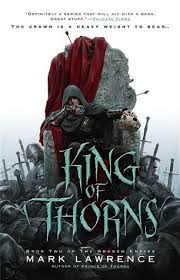
2‑King of Thorns
Chapter 21: Four years earlier
by Mark, Lawrence,The chapter “20: Four Years Earlier” serves as a flashback, providing critical context for the events unfolding in *King of Thorns*, the second installment of *The Broken Empire* series. This temporal shift delves into the protagonist’s past, revealing formative experiences that shaped his current motivations and strategies. The narrative likely explores key moments of conflict, betrayal, or personal growth, offering readers deeper insight into the character’s complex psyche and the ruthless world he navigates.
The flashback structure underscores the nonlinear storytelling technique employed throughout the series, emphasizing how past actions reverberate into the present. By revisiting events four years prior, the chapter may highlight pivotal decisions or alliances that continue to influence the protagonist’s quest for power. The tone remains dark and gritty, consistent with the series’ exploration of morality, ambition, and survival in a fractured empire.
Specific details from the chapter—though sparse in the provided excerpt—suggest a focus on the protagonist’s earlier struggles, possibly involving battles, political maneuvering, or personal losses. These events are likely instrumental in hardening his resolve and refining his tactical brilliance. The narrative may also introduce secondary characters whose roles in the past shed light on their present dynamics with the protagonist, adding layers to the overarching plot.
Ultimately, this chapter bridges the gap between the protagonist’s past and present, enriching the reader’s understanding of his journey. The flashback not only deepens character development but also sets the stage for future confrontations and revelations. By juxtaposing past and present, the author reinforces themes of consequence and the inescapable weight of history, key elements in the series’ grim and intricate storytelling.
FAQs
1. What is the significance of the chapter title “20: Four years earlier” in the context of King of Thorns: Book Two of the Broken Empire?
Answer:
The chapter title “20: Four years earlier” suggests a flashback or a shift in the narrative timeline, providing crucial background information about events that occurred four years prior to the main storyline. This technique is often used to deepen character development, reveal hidden motivations, or explain pivotal past events that influence the present plot. In King of Thorns, such a temporal shift likely serves to contextualize the protagonist’s actions, alliances, or conflicts, offering readers a clearer understanding of the broader narrative arc.2. How might the flashback structure in this chapter contribute to the reader’s understanding of the protagonist’s character?
Answer:
By employing a flashback, the author allows readers to witness formative events that shaped the protagonist’s personality, decisions, or moral compass. In King of Thorns, this could involve exploring past traumas, victories, or betrayals that define the protagonist’s current behavior. For instance, seeing the protagonist’s struggles or choices four years earlier might explain their present-day ruthlessness, ambition, or vulnerabilities, thereby adding layers to their character and making their actions more relatable or justified.3. What themes or motifs from King of Thorns could be explored or reinforced in this chapter, given its retrospective nature?
Answer:
Given the chapter’s focus on the past, themes such as power, revenge, memory, and the consequences of choices are likely emphasized. The retrospective nature might highlight how past actions reverberate into the present, reinforcing the motif of cyclical violence or the inescapability of one’s history. Additionally, motifs like broken promises, lost innocence, or the weight of leadership could be explored, as flashbacks often serve to contrast who a character was with who they have become.4. How does the author use the chapter’s structure (e.g., pacing, tone) to differentiate the flashback from the main narrative?
Answer:
The author may employ distinct pacing or tonal shifts to signal the transition into the flashback. For example, the prose might become more introspective or vivid, focusing on sensory details to immerse readers in the past. Alternatively, the pacing could slow down to dwell on key moments or accelerate during action sequences to create tension. The tone might also shift—perhaps more melancholic or raw—to reflect the protagonist’s younger, less experienced perspective, contrasting with the hardened demeanor of the present timeline.5. Why is it important for readers to experience events from four years earlier, rather than simply having them recounted by a character?
Answer:
Experiencing the events firsthand through a flashback creates emotional engagement and immediacy, allowing readers to draw their own conclusions rather than relying on a potentially biased character’s account. In King of Thorns, this technique ensures that pivotal moments—such as betrayals, battles, or personal losses—are felt viscerally, deepening the reader’s connection to the protagonist and the stakes of the story. It also preserves narrative suspense, as revelations unfold organically rather than being summarized.
Quotes
1. “The memories of men are too frail a thread to hang history from.”
This quote reflects the chapter’s theme of the unreliability of memory and how history is often shaped by subjective recollections rather than objective facts. It introduces a key philosophical question about truth and perception in the narrative.
2. “Four years can change a boy into a stranger.”
A powerful statement about transformation and the passage of time, this quote highlights the chapter’s focus on character development and the profound changes that occur between the present timeline and events four years earlier.
3. “The past is just another country - they do things differently there.”
This memorable metaphor emphasizes how the chapter contrasts past and present, suggesting that the protagonist’s earlier experiences might as well belong to a different world. It underscores the theme of how people evolve and circumstances change.
4. “Kings die. Real power lies in the hands of those who don’t care who sits the throne.”
A key insight into the political philosophy of the Broken Empire, this quote reveals the cynical truth about power dynamics that the protagonist has learned through his experiences. It represents a turning point in his understanding of governance.
